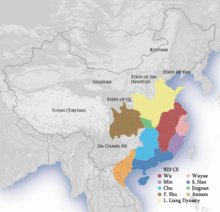Five Dynasties
| Five Dynasties | |||||||
 |
|||||||
| Traditional Chinese | |||||||
|---|---|---|---|---|---|---|---|
| Simplified Chinese | |||||||
|
|||||||
| Transcriptions | |
|---|---|
| Standard Mandarin | |
| Hanyu Pinyin | Wǔdài |
The Five Dynasties was an era of political upheaval in 10th-century China. Five states succeeded one another in the Central Plain. More than a dozen states, referred to as the Ten Kingdoms, were established elsewhere, mainly in south China.
The Later Liang, the first of the five dynasties, was established upon the fall of the Tang dynasty in 907. The era ended with the founding of the Song dynasty in 960. Many states were had military governors who were effectively independent long before 907. The Northern Han survived until 979. Poetry and wood-block printing flowered in this period. The block printing edition of Five Classics were published by Feng Dao, the Chinese Gutenberg. The canal and dam system of northern China fell into disrepair, leading to extensive flooding and famine.
Towards the end of the Tang, the growing threat of barbarian incursions led the imperial government to delegate more authority to regional military governors. The Huang Chao peasant uprising (881-884) massacred many members of the gentry class and forced others to ally with the Turks, weakening the central government. The revival of the money economy increased commerce and prosperity, but strained traditional feudal ties. By the early 10th century, many governors exercised de facto independence. Several governorships evolved into the Ten Kingdoms.
The name "Five Dynasties" was coined by Song dynasty historians and reflects the view that the successive regimes based in Kaifeng possessed the Mandate of Heaven. Yet three of these dynasties were founded by barbarian Turks, and South generally had more stable and effective government in this period.
The Five Dynasties were:
During the Liang dynasty, the warlord Zhu Wen held the most power in northern China. Although he was originally a member of Huang Chao's rebel army, he took on a crucial role in suppressing the Huang Chao Rebellion. For this function, he was awarded the Xuanwu Jiedushi title. Within a few years, he had consolidated his power by destroying neighbours and forcing the move of the imperial capital to Luoyang, which was within his region of influence. In 904, he executed Emperor Zhaozong of Tang and made his 13-year-old son a subordinate ruler. Three years later, he induced the boy emperor to abdicate in his favour. He then proclaimed himself emperor, thus beginning the Later Liang.
...
Wikipedia
